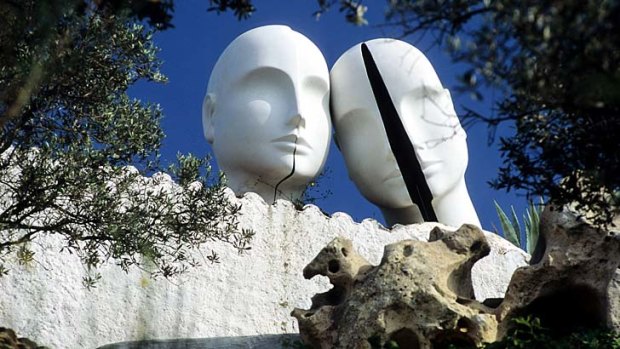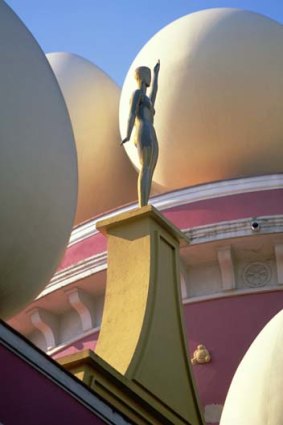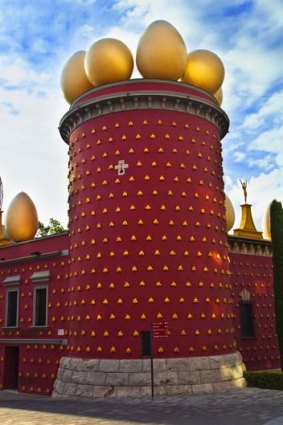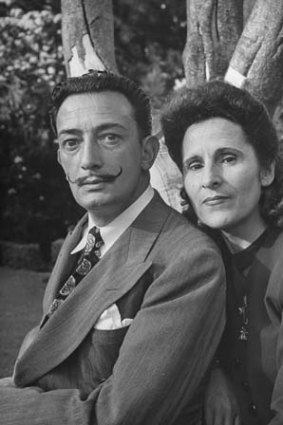
Dali's home in Port Lligat.Credit: AFP
Lance Richardson explores the carefully chosen deposits for the unique creations of pop-culture visionary Salvador Dali.
Salvador Dali once remarked that "the only difference between me and a madman is that I am not mad". Try to follow the logic of that sentence as it folds back on itself: your head will explode into slithery fragments, but not before the clocks droop from the strain and you begin to hallucinate elephants with mosquito legs.
Perhaps it's more accurate to say that the only difference between Dali and a madman is that Dali succeeded in persuading everyone to redefine madness. Visit the Museum of Modern Art in New York and you muscle past crowds admiring The Persistence of Memory. You can buy a replica Lobster Telephone on the internet or drop by Canberra's National Gallery of Australia to see an original. Dali's surreal visions have become touchstones of popular culture, ubiquitous but adored, baffling but largely unquestioned as masterpieces.

The roof of the Salvador Dali Museum.Credit: Getty Images
This is not to say they never raise questions of another sort. For example, why the recurring cypress trees, fishing boats and loaves of bread in his paintings? Who was Gala, his model and muse? Where are the milky Mediterranean skies and craggy cliffs he used as reference points?
What does it all mean, really?
While it's easy to argue that surrealist art depends on dreams and imagination, even the great masters grew up somewhere; dreams don't spring from the void. This is my reasoning as I drive from Barcelona through the Catalonian province of Girona, determined to follow Dali back to his roots by visiting three sites that make up a "Dali triangle": Figueres, Port Lligat and Pubol.

Creative genius ... the entrance to the Salvador Dali Theatre-Museum.Credit: Getty Images
"I have been made in these stones," he once said of his home. "Here I have shaped my personality, discovered my love, painted my work and built my house. I cannot separate myself from this sky, this sea, these rocks."
Here is another thing he said: "Take me, I am the drug; take me, I am hallucinogenic."
I suppose that counts as a warning.

Salvador Dali and his wife, Gala.Credit: Getty Images
Dali at work: Figueres
Dali was born in 1904 in cosmopolitan Figueres, near the border of France. Years later, the mayor of Figueres tried to acquire a painting of the city's most famous son. Dali would have none of it.
"Where, if not in my own city, should the most extravagant and solid examples of my art remain?" he asked. Not one painting for Figueres, in other words, but a Dali Theatre-Museum. In 1960, the artist bought the Municipal Theatre, a building that had been destroyed by fire at the end of the Spanish Civil War in 1939, turning it into the largest surrealist object in the world. First he painted the building maroon and stuck loaves of bread to the walls (they are made from plaster). He positioned giant eggs along the rampart and planted cypress trees out front.
Not only is the Dali Theatre-Museum a work of art in its own right, it contains some of the most recognisable pieces from Dali's career. This is the best place to start a driving tour focused on the artist: it offers both an induction to his extravagance and a retrospective of his work, with everything from Soft Self-Portrait with Fried Bacon to the legendary Atomic Leda tucked somewhere in the fray.
After standing in an interminable queue - the museum is extremely popular - I step into an open courtyard converted from the burnt-out Municipal Theatre. Here is a Cadillac with rain inside, because Dali once got wet waiting for a taxi. Here are statues like expressive Oscars, arms upraised to the open sky. Just past a ramp, draped across the stage, is a giant mural of a figure with an embryo in its head. There is a picture of Beethoven created by throwing squids at a blank canvas. Above is an enormous glass dome modelled on the eye of a fly.
The patron saint of Girona, Saint Narcis, chased away the invading French with a swarm of flies. Dali loved them. They were "dressed", he said, as if by Balenciaga.
Part of me finds the Dali Museum exhausting. Like works by the modern artist Damien Hirst, the museum is a calculated spectacle designed to engage the masses. But Hirst famously encrusted a skull with diamonds: his vision is cynical and nihilistic. By contrast, there is a room in the Dali Museum housing a heart encrusted with rubies. The heart beats. Dali may have been a showman, aware of his reputation, but he was neither cynical nor nihilistic. The artist celebrated life - celebrated living - in all its absurd detail.
Dali at home: Port Lligat
Dali lived mostly in Port Lligat, a fishing village across the hill from popular Cadaques on the Costa Brava. It is a cloudless blue day as I drive to Dali's house from Cadaques; it is like stepping from the stage of a theatre into his dressing room. Public viewings began at Port Lligat in 1997, when a foundation opened the Salvador Dali House-Museum, by timed ticket entry.
"I need the localism of Port Lligat like Raphael needed that of Urbino, to reach the universal along the path of what was private," Dali said. "One cannot understand my painting without knowing Port Lligat."
Over a period of 40 years, Dali bought fishing huts, fusing them together in a rambling, labyrinthine structure with numerous floors and unusual spaces. A polar bear, adorned with necklaces, greets you at the front entrance and sets the tone for everything to come.
"Is real," the guide tells me. "Is stuffed." And later: "The eagle, it is also stuffed."
"Stuffed" is an ideal adjective for the house in general, which is stuffed with exactly what you would expect from Dali. There is a model of a hydrogen atom, for example. A Greek statue wears the mesh helmet of a fencer near a giant cutout of a sea anemone. In the bedroom are bird cages and cricket cages (Dali liked their sound); the next room has collages of photographs of Dali meeting dignitaries such as Picasso and Walt Disney, and Dali on the cover of Time magazine.
There is also evidence of the artist at work, with brushes and turpentine scattered around the white sofa where he did much of his painting. "I cannot paint in any other place," he once claimed. "I need to be in Port Lligat, to see the sailors, the colour of the olive trees, and the bread, to feel the peace, the landscape."
Look closely at Port Lligat, with its blue Mediterranean Sea and pastel skies: The Spectre of Sex Appeal re-creates the rocky line of Cap de Creus, not far to the north. Dali's work, though random at first glance, was grounded in the specific world around him, its cypress trees and gently rocking fishing boats.
Indeed, visiting this house gives unparalleled insight into the man behind the public mask: the man who didn't like children because they moved too much; who rarely had guests (there is no guest room); who was obsessed with life, surrounding himself with bouquets of immortal flowers.
Even more than the Theatre-Museum, the house shows the interior mind made exterior.
Dali in love: Pubol
Many of his thoughts were tied to Gala, his muse and beloved Russian wife from 1934. He signed paintings with his and her name. It was mostly with her blood that he painted his pictures, the artist once claimed, though he also defined an elegant woman as "a woman who despises you and has no hair under her arms". Dali had complicated attitudes towards women.
Nevertheless, the last stop on the Dali triangle takes me to Pubol, where a converted 11th-century castle affirms his admiration for his older spouse (that is her, for example, reclining in Atomic Leda). Having promised Gala a castle of her own, Dali bought her this one when she was 76. She thanked him. Then she forbade him from visiting without an invitation. He complied, always bringing gifts, whether a porcelain chariot or a handful of acorns.
The castle at Pubol is a low-key affair compared with the Theatre in Figueres and Theatre-Museum at Port Lligat.
The garden reminded Gala of Russia, though Dali adorned it with a dozen busts of the composer Wagner - and a vomiting codfish. The building strikes me as elegant, with high rooms and sweeping views of the surrounding countryside and, were it not for odd touches such as the tapestry of a man trapped inside a burning giraffe, it could almost be mistaken for a nobleman's estate.
In one sense, the castle provides a final testament of the woman behind the man behind the artifice - there are artworks by Gala (a Jesus wrapped in tinfoil) and photographs of her laughing on the floor near her piano, socialising with younger men.
"Gala had started to explain to me in great detail the reasons for her desire and it occurred to me suddenly that she also had her inner world of desires and failures and she moved at her own pace between the poles of lucidity and madness." Dali sounds surprised to learn that his muse had musings of her own.
Nevertheless, Gala remains largely elusive, a symbol swamped by the curios of the famous man she motivated. The day she died, Dali stopped work entirely. His final canvas sits in the drawing room, blank but for a black line like the cut in a violin.
Gala is buried in a crypt at Pubol alongside a horse's head, giraffe and the bust of a man. This is the most private of Dali's spaces, so it seems appropriate that the source of his inspiration should be laid to rest here. But though Dali built the crypt for two, an accident with fire drove him away in the final years of his own life.
Dali died at Figueres, coming full circle. When you visit the Dali Theatre-Museum, look out for a large square in the floor. Dali is buried on the stage of his own creation. Perhaps this is perfect for an artist who once described himself as "eminently theatrical".
Lance Richardson travelled courtesy of Spain Tourism and Rail Europe.
ARTISTS IN RESIDENCE
Pablo Picasso. Most popular is the Picasso Museum in Barcelona, but travellers looking for Guernica should head to the Reina Sofia in Madrid. See museupicasso.bcn.es, museoreinasofia.es.
Francisco Goya. Sometimes called the father of modern art, Goya is renowned for dark subject matter. Many masterpieces can be seen in the Prado Museum, Madrid. See museodelprado.es.
Joan Miro. This Catalan artist is celebrated at a superb Barcelona museum on the Montjuic hill overlooking the city. See fundaciomiro-bcn.org.
Diego Velazquez. He had a profound influence on Dali and Picasso and his works can be seen across the country. A good starting point is the Museum of Fine Arts in Seville. See museodebellasartesdesevilla.es.
El Greco. A key figure in the Spanish Renaissance, El Greco confused contemporaries but became adored by modernists for his individualism. A museum in Toledo's Jewish Quarter houses many of his works. See museodelgreco.mcu.es.
FAST FACTS
Getting there
Singapore Airlines has a fare to Madrid for about $2260 low-season return from Sydney and Melbourne, including taxes. Fly to Singapore (about 8hr), then Munich (13hr), then to Madrid (2hr 45min). See singaporeair.com. This fare allows you to fly back from another European city. An easy way to traverse the Costa Brava is by rail. Eurail Select Passes covering Spain and the rest of Europe start from $366. See raileurope.com.au.
Staying there
A convenient base for the Dali triangle is Mas Salvi Hotel in Monells. It's only a short drive from the mediaeval village of Peraallada, which is famed for its carved buildings. Rooms cost from about €235 ($303) a night. See massalvi.com.
The Dali triangle
The Dali Theatre-Museum in Figueres is the centrepiece of Dali's creative empire. Tickets cost €12 a person. In Port Lligat, near Cadaques, the Salvador Dali House-Museum is accessible by timed ticket only. Advance purchase is recommended. Tickets are €11 a person. Gala's castle at Pubol is the least-visited site on the Dali triangle, meaning fewer people. Tickets cost €8 a person. See salvador-dali.org.
More information visitspain.info
Sign up for the Traveller Deals newsletter
Get exclusive travel deals delivered straight to your inbox. Sign up now.